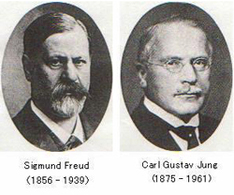 When doing dream work, we’re looking for the hidden connections between a dream image and an experience in our waking lives. The battle between Freud and Jung proved that what you’re looking for can influence what you find.
When doing dream work, we’re looking for the hidden connections between a dream image and an experience in our waking lives. The battle between Freud and Jung proved that what you’re looking for can influence what you find.
Vivid dreamers have a lot to be grateful to Sigmund Freud for. It was he who gave credibility to our eternal hunch that dreams are more than they seem. Together with his protege, Carl Jung, Freud championed the radical idea that the objects in our dreams are in fact living images, just as energetically alive as you and me.
As Jung evolved as a psychiatrist, his own experiences led him to challenge Freud’s views. Freud took this as a personal betrayal, and painfully, their relationship was doomed.
Perhaps we are the lucky beneficiaries of their strong mindedness. They left us with not one, but two legacies that have helped shape modern
psychology and given birth to psychoanalysis.
Freud and Jung’s work with living images in dreams has transformed our understanding of the psyche’s healing process, and introduced into the mainstream the notion that our psyche extends far beyond the conscious mind.
What follows is an example of the central technique each man contributed to modern dream work. Try them both on your own dream images, and explore what feels true to you.
Freud’s Method of Association
Freud believed that dreams are metaphors for latent wishes and repressed aggressive sexual desires too disturbing for us to encounter directly. In order uncover the material hidden in our dreams, we free associate until we find the connection between a dream image and a past experience. For example, an association on a dream of a dog may look like this: Large dog > walk in the park yesterday > spoke to auntie in the park > deep frustration with mother > sense of emotional abandonment. At this point I may sense in my body that my dream is connected to feeling emotionally abandoned by my family.
Today, many feel this method of association is untrustworthy, as you can often end up very far from the symbol itself. You can get around this by always returning back to the original symbol for each association. This provides quite a different results. For example: Large dog > walk in the park; Large dog > chased as a childhood; Large dog > guard dog, etc.
Jung’s Method of Amplification
Jung believed that dreams depict more than our personal repressed material. They are informed by what he called “the collective unconscious”:
cultural forces that accumulate energetically over thousands of years, and that inform global myths, fairy tales and world religions. For Jung, dream
work is a process of discovering how a dream image connects to universal themes that have come alive in our own life experience. Amplification with the same dream dog from above may look like this: Large dog, loyalty, pack animal, being guarded, companion, obedience, domestication. As I do this, one amplification may ‘click’ for me as personally relevant, filling me
with conviction, and informing my interpretation of the dream.
To be clear, Jung was also a great believer in free association, and evolved Frued’s technique for use with his own clients. Freud also couldn’t help but support his clients to amplify their symbols. The two techniques, when used professionally, are highly complimentary.
Each technique has its own merits, leading you to different places in your self and in your life. Rather than letting your mind decide which is true, trust your body to give you a sign when you’ve hit upon something that feels alive at the heart of the living image in your dream.
